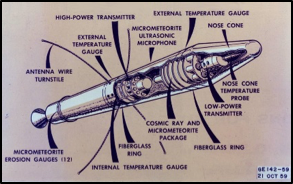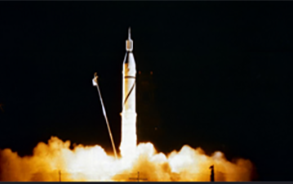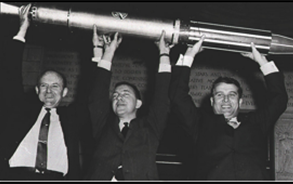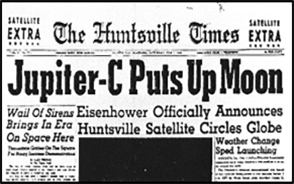About Explorer 1
In the mid-1950s the Cold War was running hot. The U.S. and U.S.S.R. each sought to gain an edge over the other with new technologies and weapons developed during World War II and in the burgeoning Atomic Age. The competition to put a satellite into orbit ― a goal of the International Geophysical Year (IGY), which ran from July 1, 1957 to Dec. 31, 1958 ― was particularly intense.
3D Model: Click (or touch) and drag to interact with this 3D model of the Explorer 1 spacecraft.
When the beeping signal of Sputnik 1 was picked up by receivers around the world in October 1957, there was no doubt the Soviet Union had scored a victory politically, militarily, scientifically and symbolically. When it did it again with Sputnik 2 less than a month later, the pressure on the U.S. to get into the "Space Race" intensified.
The administration of President Dwight D. Eisenhower "had to move quickly to restore confidence at home and prestige abroad," wrote former NASA Chief Historian Roger D. Launius. The White House invited the news media to cover the test launch of a Project Vanguard booster on Dec. 6, 1957 "in the hope that it could help restore public confidence, but it was a disaster of the first order," Launius wrote.
The Navy’s Vanguard rocket lifted up barely 3 feet before it toppled over and exploded just a few seconds after launch.
The government quickly turned to the Jupiter-C rocket developed by Wernher von Braun and his team at the Army Ballistic Missile Agency (ABMA) in Alabama, who had been working with the Jet Propulsion Laboratory in California under the direction of William Pickering on building the satellite, which would carry an experiment to measure the "cosmic rays" around Earth developed by University of Iowa physicist James Van Allen.
Satellite 1958 Alpha, later and better known as Explorer 1, successfully lifted off from Cape Canaveral, Florida on Jan. 31, 1958. At a jubilant early-morning press conference a few hours later, Pickering, von Braun and Van Allen hoisted a model of Explorer 1 over their heads in what has become an iconic photograph.
The success of Explorer 1 and other satellites that soon followed in 1958, lead Congress to pass the National Aeronautics and Space Act that summer, which was signed into law by President Eisenhower on July 29, 1958. On Oct. 1, 1958 NASA opened for business.

The Science
The science section of the satellite, designed by University of Iowa physicist James Van Allen, was relatively straightforward. It took up 37.25 inches (94.62 cm) of the satellite’s total 80.75 inches (205.12 cm) length. The main instruments were a cosmic-ray detection package; internal, external and nose-cone temperature sensors; a micrometeorite impact microphone; a ring of micrometeorite erosion gauges; and two transmitters. There were two antennas in the body of the satellite and its four flexible whips that formed a turnstile antenna, which were kept extended by the rotation of the satellite. Electrical power for the transmitters was provided by batteries that made up 40 percent of the total payload weight. Image credit: NASA/Marshall Space Flight Center Collection.
The Launch
Explorer 1 was carried into orbit by a Jupiter-C rocket, launched from Cape Canaveral, Florida, at 10:48 p.m. (EST) on Jan. 31, 1958. The rocket, developed at the Army Ballistic Missile Agency in Alabama, under the direction of Wernher von Braun, was a modified version of the Redstone ballistic missile, topped by three solid-propellant upper stages. The second and third stages, clusters of 11 and three scaled-down Sergeant rockets, respectively, were clustered in a "tub" atop the vehicle, and the fourth stage, which carried the satellite, was mounted on top of that. When assembled, all four stages of the vehicle stood 71.25 feet (21.72 meters). When used as a satellite launching vehicle, Jupiter-C is sometimes referred to as the Juno-1. Image credit: NASA
The Celebration
"The decision was made that we would make no public comments about the rocket until [its signal] had actually been picked up in California," then-Director of the Jet Propulsion Laboratory William Pickering (far left) said in a later interview. "And we sat there for an hour-and-a-half. The time came and went, and there was a period of 8 minutes there [before contact], which is the longest 8 minutes I’ve ever spent in my life." At a jubilant press conference about 2 hours after the launch, Pickering was joined by James Van Allen (center), head of the University of Iowa physics department who designed the science instruments, and Wernher von Braun (right), who directed development of the rocket at the Army Ballistic Missile Agency. Image credit: NASA
The Success
The successful orbit of Explorer 1, launched on a Jupiter-C rocket, made headlines around the world. The Soviet Union had already launched two satellites in 1957, and the previous U.S. attempt on a Vanguard rocket exploded only a few seconds after liftoff. At the time, many people called the satellite a “moon” or a “man-made moon” because of its Earth orbit. The Huntsville Times, seen here, was particularly proud of the success of the Jupiter-C, as it was made at the Army Ballistic Missile Agency in Huntsville, Alabama. Image credit: NASA
The Van Allen Belts
Data from Explorer 1 and Explorer 3 (launched Jan. 31 and March 26, 1958, respectively) detected the existence of charged particle radiation trapped by Earth's magnetic field ― the inner radiation belt. Pioneer 3 (launched Dec. 6, 1958) and Explorer IV (launched July 26, 1958) also carried instruments designed and built by James Van Allen of the University of Iowa. These spacecraft provided Van Allen additional data that led to the discovery of a second, outer radiation belt encircling the inner belt. Today, these radiation belts around Earth are called the Van Allen Belts. Artist’s depiction by: NASA/Goddard Space Flight Center/Scientific Visualization Studio.
The Big Picture
This 1958 “official television report of the United States Army” recounts the “exciting, suspenseful story” of the days leading up to the launch of Explorer 1, the first “scientific Earth satellite.” Footage includes development of the rocket at the Army Ballistic Missile Agency in Alabama, building the satellite at the Jet Propulsion Laboratory in California, launch from Cape Canaveral in Florida and, finally, the celebratory press conference in Washington, D.C.
Fast Facts
Explorer 1 was the first successful U.S. satellite. It was launched Jan. 31, 1958 at 10:48 p.m. (EST) from Cape Canaveral, Florida, after two days of launch delays due to high winds. The Jupiter-C launch rocket was built at the Army Ballistic Missile Agency in Huntsville, Alabama, under the direction of Wernher von Braun. The science components were designed and built by James Van Allen, head of the University of Iowa physics department. The satellite was constructed at the Jet Propulsion Laboratory in Pasadena, California, under director William Pickering. The satellite was 80.75 inches (2.05 meters) long and weighed 30.66 pounds (13.90 kg), 18.35 pounds (8.32 kg) of which was from instrumentation. Coupled with the Jupiter-C rocket, the vehicle stood 71.25 feet (21.72 meters) and weighed 64,000 pounds (29 metric tons) when loaded for launch. Explorer 1 orbited Earth approximately every 114.8 minutes, making 12.54 orbits each day. Explorer 1 stopped transmitting when its batteries ran out on May 23, 1958, although it stayed in orbit until March 31, 1970, completing 58,376 orbits.

